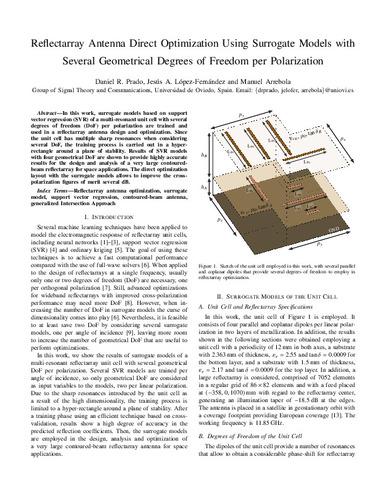Reflectarray antenna direct optimization using surrogate models with several geometrical degrees of freedom per polarization
Subject:
reflectarray antenna optimization
surrogate model
support vector regression (SVR)
contoured-beam antenna
generalized intersection approach
Publication date:
Publisher version:
Descripción física:
Abstract:
In this work, surrogate models based on support vector regression (SVR) of a multi-resonant unit cell with several degrees of freedom (DoF) per polarization are trained and used in a reflectarray antenna design and optimization. Since the unit cell has multiple sharp resonances when considering several DoF, the training process is carried out in a hyper-rectangle around a plane of stability. Results of SVR models with four geometrical DoF are shown to provide highly accurate results for the design and analysis of a very large contoured-beam reflectarray for space applications. The direct optimization layout with the surrogate models allows to improve the cross-polarization figures of merit several dB.
In this work, surrogate models based on support vector regression (SVR) of a multi-resonant unit cell with several degrees of freedom (DoF) per polarization are trained and used in a reflectarray antenna design and optimization. Since the unit cell has multiple sharp resonances when considering several DoF, the training process is carried out in a hyper-rectangle around a plane of stability. Results of SVR models with four geometrical DoF are shown to provide highly accurate results for the design and analysis of a very large contoured-beam reflectarray for space applications. The direct optimization layout with the surrogate models allows to improve the cross-polarization figures of merit several dB.
Description:
IEEE MTT-S International Conference on Numerical Electromagnetic and Multiphysics Modeling and Optimization, NEMO 2022 (2022. Limoges, France)
Patrocinado por:
This work was supported in part by the Ministerio de Ciencia, Innovación y Universidades under project IJC2018-035696-I; by the Ministerio de Ciencia e Innovación and the Agencia Estatal de Investigación within project ENHANCE-5G (PID2020-114172RB-C21 / AEI / 10.13039/501100011033); by Gobierno del Principado de Asturias under project AYUD/2021/51706.
Collections
Files in this item





